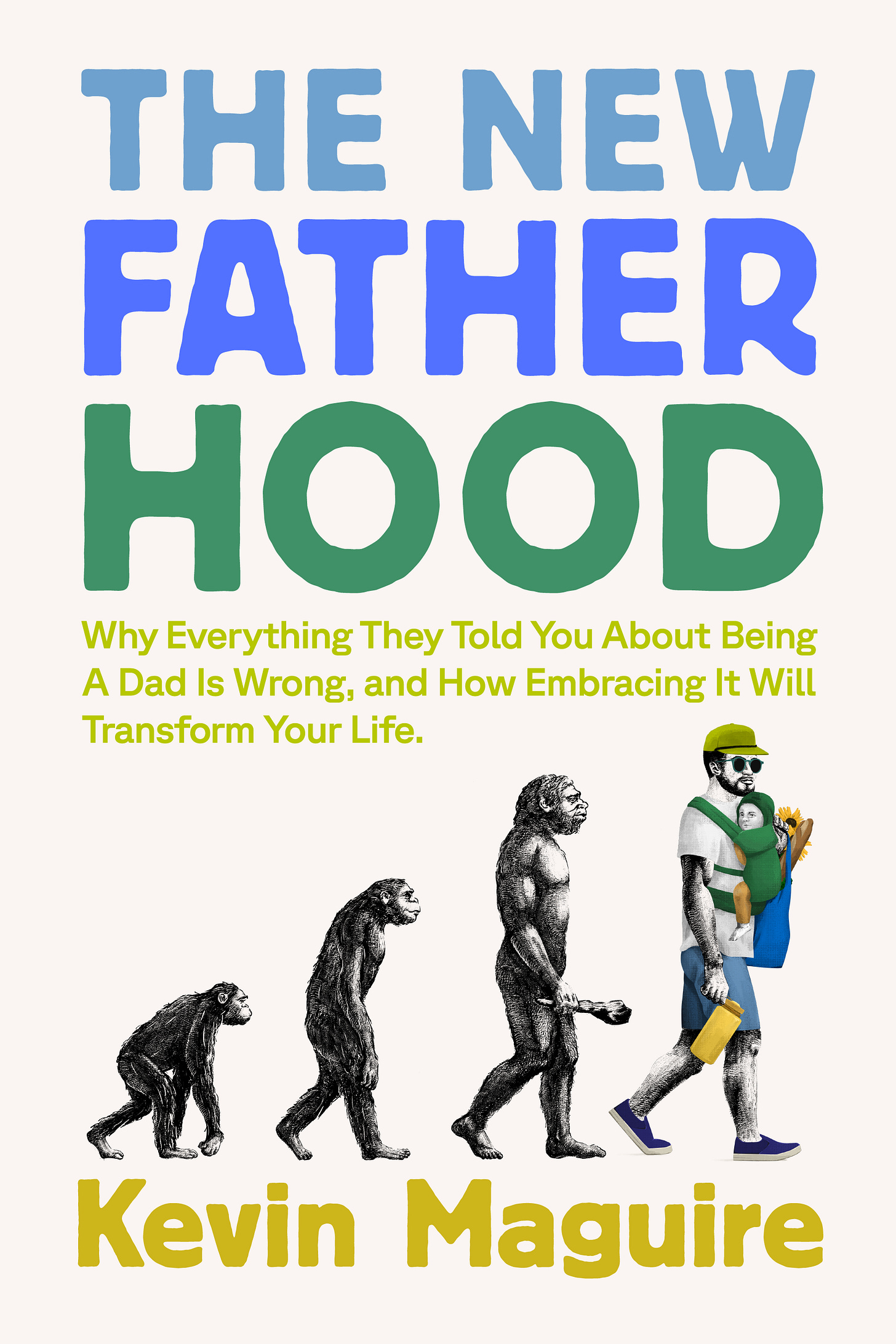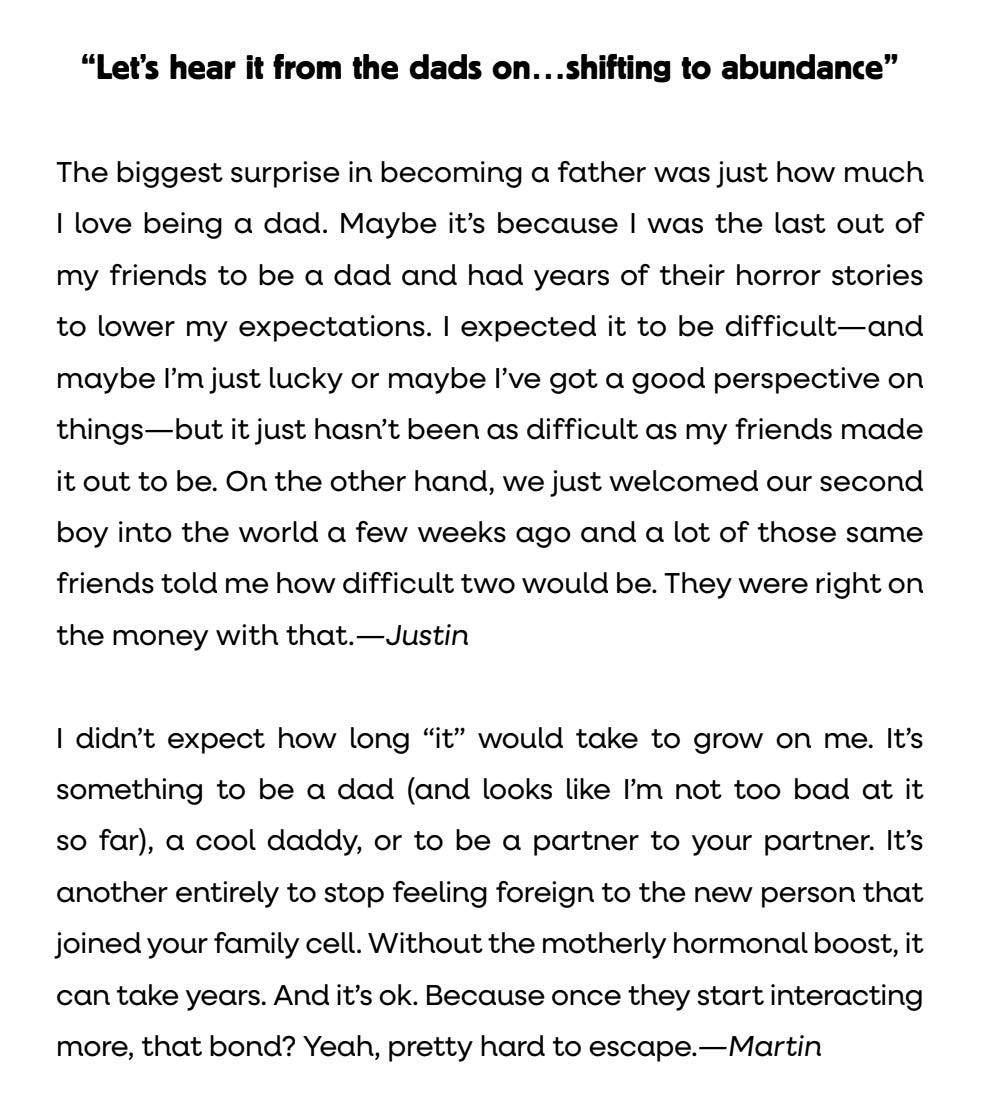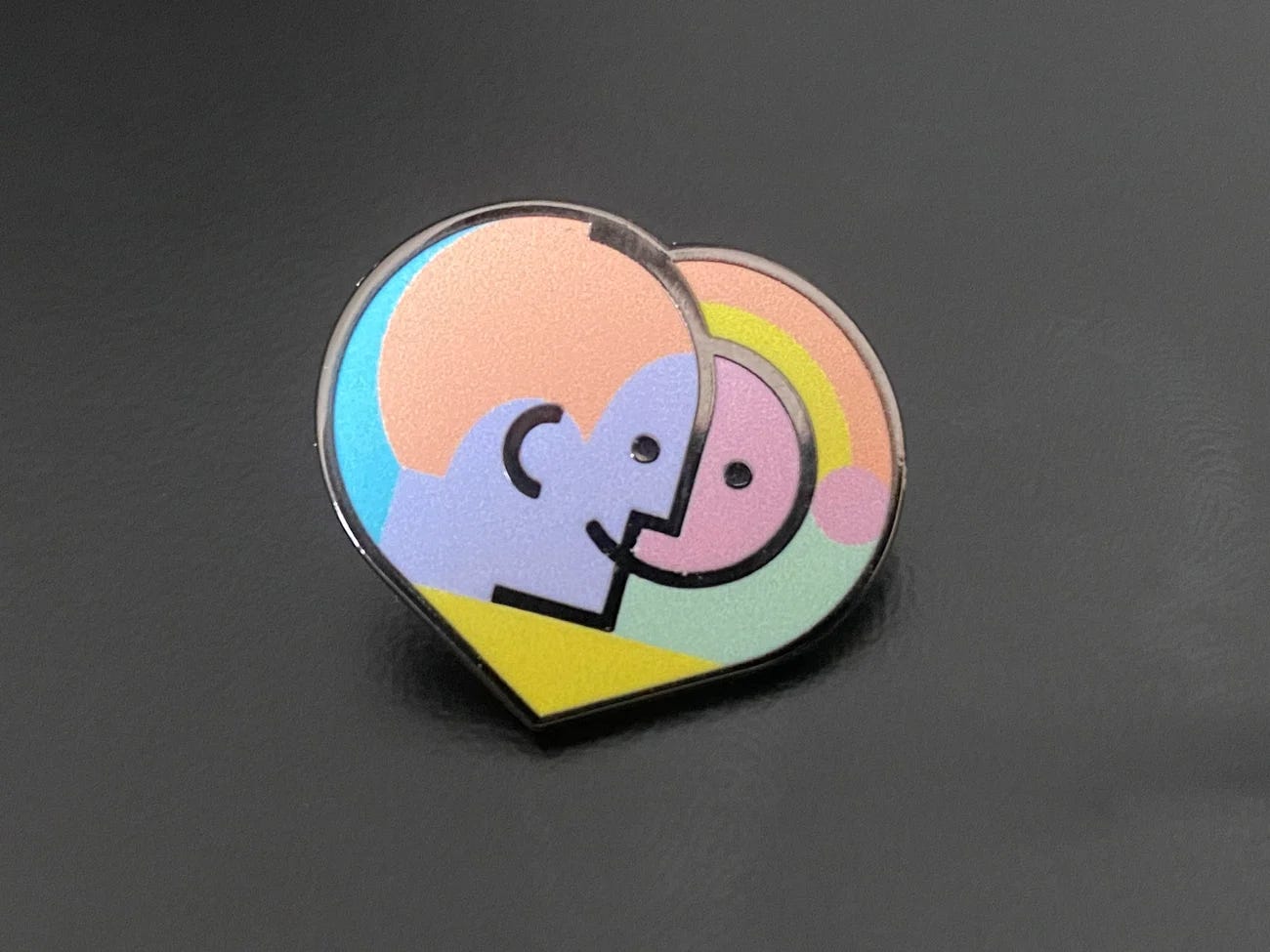The book is (almost) done. Want to see the cover?
Dispatches from the final edit, and a free gift for the first 200 dads in line
My attempt to not bury the lede: the book is almost over the line. Every time I feel like we’ve hit this stage, I am informed, “close, but no cigar.” But now, I’m nearly done. Things are starting to move into place: if you’re in the US, you can pre-order it using this evil Bezos link or this kind independent Bookshop.org one. If you do go to Amazon—and no shame here, life is complicated enough—then thanks to a graceful hacking of their affiliate scheme, that link will direct ~5% of your cash away from Bezos’ deep pockets and towards a fund helping dads get access to therapy. (Non-US links will be coming very soon.)
To celebrate pre-orders going live, I’ve re-upped the iconic TNF Heart-Shaped Badge and am giving away 200 of them. Head to the bottom to figure out how to claim yours.
The Irish playwright George Bernard Shaw once observed that England and America were “two countries separated by a common language.” It’s a quote I circle back to often as I write this newsletter. I was born in the UK to Irish parents and raised on a cultural media diet that, in the 1990s, was primarily from the other side of the Atlantic: ER, The X-Files, Friends, Frasier, Seinfeld, and—of course—The Simpsons.
Before music took over my life, The Simpsons was my first obsession. I loved it more than life itself. It came into my life memorably: nine years old, my school teacher, Mr Yates, handed me a VHS cassette and said, “I think you’ll like this.” (Can you imagine such a thing happening today? We grew up in simpler times.) It offered a rabbit hole that I fell right into. My sisters and I ground that tape into dust before pestering our parents to pleeeeeease get Sky TV (the only way you could watch the show in the UK, outside of pirated VHS recordings) so we could get it straight from the source. It became the lingua franca of our childhood. We still quote lines to each other regularly.
Once we had access to satellite television (here, have all the Simpsons in the world!), we began making our own compilation tapes and consuming these on repeat. My granny once asked our parents whether our TV was broken because it kept showing the same show on a loop, whenever she was in the house, and “why was it always so yellow?” Because of The Simpsons, I have a good answer for when the kids ask me, “What did you do before Netflix?” (Last month, my eldest told me she thought I spent my childhood watching black and white TV. Ouch. I’m greying, not ancient.)
The show played fast and loose with cultural references: in a heartbeat, it would move between a McBain, a parody of the bombastic attitude of Arnold Schwarzenegger’s 1980s purple patch, to a reinterpretation of Citizen Kane (in the iconic season five episode “Rosebud”), or watching class nerd Martin playing a My Dinner with Andre arcade game.1 These influences would come together in a way that still, to this day, echoes the memory of a great meal, wondering what drove the chef to pair certain ingredients together: one episode blended the plot of Martin Scorsese’s 1991 Cape Fear remake with the collected works of musical pioneers Gilbert and Sullivan, whilst also finding time to create an unforgettable scene of Homer heading into witness protection. As a young child, these references were so far over my head they were in danger of hitting the very satellites that were beaming the show into our home. But I was curious, as all good kids should be. I went asking. My parents didn’t have the answers. But I’d find them, eventually.
In the early days of the internet—so far back that the idea of social media wasn’t even a twinkle in Zuckerberg’s testicles—we went online to feed our curiosities, to seek out others who shared the same passions and interests as we did. I used nascent platforms to find my tribe, in a pattern I would repeat throughout my adult life. For the first time, but not the last, I found my people online. The Simpsons Archive (formerly snpp.com) was exactly what I was yearning for: weekly episode recaps that explained hidden jokes, freeze-frame gags, and cultural references. Looking back, what they were providing wasn’t a million miles away from a weekly newsletter. Everything old is new again.
Some of the show’s references I understood. Others would zoom by on the first pass, only to click many years later, when I finally had the cultural fluency to comprehend the joke I had completely missed. (Oh, I get it. I get jokes.) A lot has been written on the world-class nature of the show’s writing team (if you’re a fan and haven’t read Springfield Confidential, go buy it right now), and rightly so—they were amongst the best to ever do it, an alumni group that went on to shape the golden age of US comedy, including The Office, Parks & Recreation, King of the Hill, Futurama, and more. Their collective knowledge served as an on-ramp to movies, shows, and books I might have eventually found, but surely at a much later stage in my life.
It’s still a regular occurrence, years into writing this newsletter, that I’ll meet a dad surprised by my Mancunian accent. I thank The Simpsons for this: the show’s writers generously shared the references that had lit up their world, I consumed them furiously, and by the time I was in my twenties (and the show’s best years were well behind it) I could code-switch easily between the two dominant variations of the English language. I’m quite sure it contributed to my success working for a US company: first in London, then in San Francisco. Keeping this veil in place requires some creative license—one example, amongst many: I try to never refer to nappies/diapers in this newsletter, knowing it’s a parenting third rail, a fatherhood shibboleth that instantly separates dads on different sides of the Atlantic.
My cultural fluency has gotten me far, but it’s all been a facade. I’ve finally been rumbled—by a lovely woman named Amy, who has been assigned to be my copy editor on this last pass of the book.
Between fatherhood, coaching (including wrapping up the first six-month program with a small group of dads), branding and positioning work with startups, a weekly newsletter deadline, and getting the book over the line, I’ve spent a lot of time spinning plates over the last year. Some continue to wobble. A few have fallen over, smashing into smithereens. But we’ve made it work. I’m coming out of the other side, with exciting times ahead.
With the big slope marked “writing the book” almost ascended, I’m approaching a short plateau before attempting to climb the summit marked “launching it.” I’m close. But a final foe sits in my path, one that must be defeated. It has been a longtime nemesis who has loomed over my life and career, someone I’ve spent my entire adult life battling. Its name? Microsoft Word. This fight was one I gave up on long ago, knowing I could never win, when I became a loyal disciple of Google Docs, a tool that’s never crashed on me mid-deadline. But just as the entire finance industry runs on Microsoft Excel, the publishing industry continues to use Microsoft Word as its primary form of knowledge retention and transfer.
So this week’s missive comes as a moment of respite during this final round of edits—as I see all the times I’ve recognised something being corrected to recognized, as my hundred-plus uses of whilst are gently pushed back to while. 150 pages down, 150 left to go, and writing this feels like a splash of water over my head as I use a piece of software that doesn’t feel like I’m punching myself in my face. Amy, the suggester of these final suggestions, has written many books of her own, and is helping me navigate those blind spots in my US cultural understanding—like the fact you Americans have no idea what a space hopper is—alongside small intricacies in language that will hopefully increase the chance of you loving this book rather than being wildly offended by it.
I am almost there. I can smell it. A few weeks ago, we locked the cover art. I could tell a longer story with another thousand words about how it went, and maybe one day I will, but for now, it’s enough to say that my long-time collaborative partners at Selman Design—fresh off being crowned Design Agency of the Year by AdAge—once again knocked it out of the park. They suggested a cover concept so beloved by all who saw it that the publisher asked them to take the reins and design it. (If you know anything at all about the book industry, the fact that I was able to have such a say in the cover of my first book will be as much of a shock to you as it was to my agent.)
Here’s what you’ll see, in a bookstore near you, in May 2026.
And when you turn it over, here’s what you’ll read.
Fatherhood will change you. That much is certain.
But whilst it can never be under your control, it can be under your influence.The old rules of fatherhood are no longer fit for purpose. It used to be simple: you had to protect, provide for, and preside over your family. But the world has changed, and today’s dads are questioning the role they play in society, at work, and in their homes, as they feel the once-solid foundation of fatherhood crumble beneath their feet.
This once-in-an-era shift has sent dads searching for answers. Thousands found them in their inboxes, via The New Fatherhood, the #1 fatherhood newsletter on Substack. For five years, Kevin Maguire has interviewed some of the world’s best thinkers, studied the output of our finest creative minds, and dove deep into the archives of peer-reviewed parenting. This book transforms those sources into an updated operating system for modern dads: delivered through deeply personal stories, transformative perspectives on success and sense of purpose, compact frameworks, habits that stick, and techniques you can apply in even the most turbulent moments.
And it won’t just look beautiful on the outside: my other design-partner-in-crime Tony Johnson has adapted some of his finest illustrations for the newsletter into grayscale, which will be spread throughout the pages of the book. Here’s one of four:
Thought my name is on the cover, I didn’t write this book on my own. It had been shepherded into existence by so many of you: the dads who jumped into open comment threads in the early days of the newsletter, the ongoing conversations we have in the Dadscord every day, all the ways that the dads in the orbit of this newsletter continue to show up for each other. Every chapter ends with a “let’s hear it from the dads” section, in which I hand the megaphone over to some of the most powerful things I’ve heard from you throughout the years.
Ready to pre-order and get a free badge?
There will be a LOT of pre-order goodness coming up for this: online book clubs, live conversations with dads that will hopefully be coming to a city near you, and a whole host of digital goodies that I can’t quite talk about yet. But I couldn’t let this moment pass without offering up a little something for those first in line. To celebrate the launch of the book, I’ve re-upped one of the best things ever to come out of this humble newsletter: the TNF Heart-Shaped Badge, designed by Selman Design (of course) in Brooklyn, NY, and manufactured by an ethical, artist-owned manufacturer. This badge is the perfect way to signal to the entire world that you’re a man of refined taste who believes in being the best dad that he can. This pin badge is 25mm / 1 inch wide, and comes with my eternal gratitude for choosing to support the work I’m doing here.
Pre-orders are only live in the US right now (other links are coming, I assure you). You can pick it up on Amazon, or support your local bookseller on Bookshop.org. The first 100 dads (or curious moms, who are always welcome here) who purchase the book and fill out this form will get their badge in the mail early next year. All you have to pay for is postage, I’ll cover the rest. If you’re a non-US dad, and the words “FREE BADGE” have got all your neurons firing, you can sign up for an annual subscription to the newsletter, come join us in the Dadscord, fill out the form I’ll make sure one of those heart-shaped badges finds its way to your doorstep next year.
And that’s it
Thanks again for being here — for reading, sharing, and helping me get this far. I can’t wait to share what’s coming next. Lights cigarette … How was this somewhat self-congratulatory essay for you?
Loved | Great | OK | Meh | Bad
Branding and book cover by Selman Design. Illustration by Tony Johnson. Hit that comment button below and tell them how great their work looks.
Someone finally made My Dinner with Andre into a real game. Go play it.








Huge congratulations, Kevin. Watching you take this from a newsletter to a book has been inspiring. The cover is perfect. It has that clean, confident feel that matches the heart of what you write. You have helped a lot of dads find their footing, me included. I cannot wait to have this on my shelf.
Congrats! The cover looks great